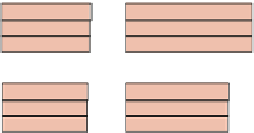Information Technology Reference
In-Depth Information
CLASS_TYPE
FEATURE
EXPRESSION
+name : NAME
+is_ref : BOOLEAN
+is_exp : BOOLEAN
+attributes : TUPLE
+functions : TUPLE
+procedures : TUPLE
+inv_exists : BOOLEAN
+inv : EXPRESSION
+name : NAME
+formals : TUPLE
+is_once : BOOLEAN
+pre_exists : BOOLEAN
+pre : EXPRESSION
+post_exists : BOOLEAN
+post : EXPRESSION
+locals : TUPLE
+body : TUPLE
+is_exported : BOOLEAN
+class_type : CLASS_TYPE
ENTITY
LITERAL
QUERY_CALL
+name : NAME
+context_feature : FEATURE
+obj : OBJECT
+feature_by_name(in name : NAME) : FEATURE
INSTRUCTION
ROUTINE
ASSIGNMENT
COMMAND_CALL
CREATION_INSTRUCTION
FUNCTION
PROCEDURE
ATTRIBUTE
IF_INSTRUCTION
LOOP_INSTRUCTION
Fig. 1.
ADTs for the intermediate representation
returns the result. This computation must not modify the state. A procedure performs a
computation that modifies the state. Functions and procedures are also known as rou-
tines. For each of these categories,
CLASS TYPE
defines a query that returns a tuple
of features. The query
attributes
returns a tuple of attributes, the query
functions
returns
a tuple of functions, and the query
procedures
returns a tuple of procedures. If the name
of a feature is known, then the query
feature by name
can be used to get the feature
with that name. Each class type can have an invariant. The query
inv exists
indicates
whether such an invariant exists. In case an invariant exists, it can be accessed with the
query
inv
as an expression. One of the instances of
CLASS TYPE
is
BOOLEAN
.This
class type is expanded and it has an attribute with name
item
. The value of this attribute
is the represented boolean value, i.e., an instance of
BOOLEAN
.
In this formalization, a feature is an instance of
FEATURE
. The name of the feature
can be retrieved with the query
name
and the formal arguments are given by the query
formals
that returns a tuple with the formal arguments as entities. Whether or not the
feature is a once feature can be determined using the query
is once
. The queries
pre
and
post
return an expression for the precondition respectively the postcondition, provided
that the queries
pre exists
and
post exists
indicate that the assertions exist. Next, there
is the query
locals
that gives the locals of the feature as entities. The query
body
returns
the body of the feature as a tuple of instructions. Each feature is either exported or not.
A non-exported feature is only available in calls on the current object within the class
that declared the feature. An exported feature can be called by other clients as well. The
query
exported
returns whether a feature is exported or not. Lastly, each feature has a
link to the class it belongs to. This is given by the query
class type
. This can be used for
example to retrieve the invariant that must be preserved by a feature. For each feature
category, there is an ADT that inherits from the
FEATURE
ADT.
Expressions can either be entities, literals, or query calls. Every expression is an in-
stance of
EXPRESSION
. For each form of expression, there is one ADT that inherits
from the
EXPRESSION
ADT. For entities there is an ADT with a query
name
that











































































Search WWH ::

Custom Search